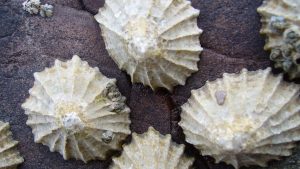
Limpet, Heal Thyself…
What’s the most stubborn creature you can imagine? No, not a toddler in the middle of a tantrum. Not a dog with a bone. Not even Jack Black when it’s time to give up the stage….
Meet the limpet, the marine mollusk with a shallow conical shell. Yeah, they may not be the first thing that come to mind here, but limpets really are the very definition of tenacious. When a limpet clamps down onto a rock surface, it’s sealed up like Fort Knox. The limpet will allow itself to be destroyed before it lets go of the rock it’s clamped onto.
Limpets live all over the world in tidal areas (the Slipper Limpet, which is native to the East Coast of North America, is invasive in many parts of the UK and Ireland). They may stray from their home spot to find food, but they find their way back home again before the tide goes out. Limpets eat algae that grows on the rocks where they live by scraping the surface with ribbon-like tongue that has rows of teeth, called a radula. Their primary predators underwater are crabs and sea stars, and birds are their biggest threat when the tide is out.
Limpets can live more than 15 years, and have some interesting survival tricks up their shells, so to speak. Some species of limpet have been discovered to undergo a male to female sex change. In this particular species of limpet, all of the small individuals are male; once they reach a certain size, they change to become female.
But even more interesting to many researchers are their healing properties. Bioengineers at Trinity University in Dublin, Ireland, have discovered that limpets are able to remodel their shells when damaged. The research team simulated the kinds of stresses limpets experience in their natural habitats, such as environmental stresses that might occur in rough seas, or aging stresses from shell weathering, and even survival stresses, like limpets would endire when being attacked by birds or other predators. These limpets actively repaired their shells by depositing new biological material, in a process similar to how bones heal in mammals. After 60 days, the shells were back to their original protective strength, though they were never as thick as before.
Ultimately, limpets may seem unassuming and even fragile, but they are indeed a quite stubborn species, determined to survive and grow in all manner of environments, and we may yet learn a lot about our own abilities to adapt and survive by watching these little creatures more closely.
Source:
- https://www.wildlifetrusts.org/wildlife-explorer/marine/sea-snails-and-sea-slugs/slipper-limpet
- https://invasivespeciesireland.com/species-accounts/established/marine/slipper-limpet
- https://oceana.org/marine-life/cephalopods-crustaceans-other-shellfish/common-limpet
- http://www.universitytimes.ie/2018/08/trinity-bioengineers-discover-self-healing-abilities-of-seashore-creatures/
Curriculum Reference Links
- Nature of Science / Understanding About Science / 1: Students should be able to appreciate how scientists work and how scientific ideas are modified over time


